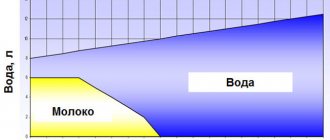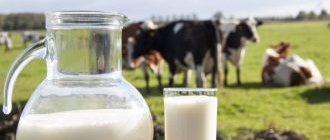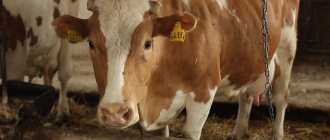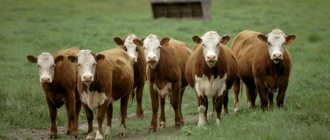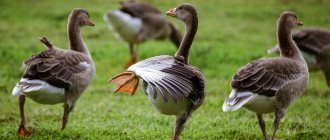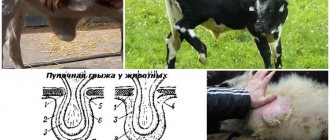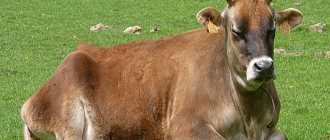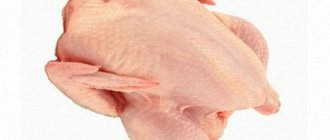Fattening calves
The diet of dairy bulls for fattening up to 1 month consists of colostrum.
The food concentrate is gradually introduced on days 28-30 of life. There is no grass or roughage in the food chain. In young animals, the rumen has not yet formed, so the digestive system cannot cope with roughage; it is better to supplement the diet with age-adapted feed. Fattening of dairy young animals does not depend on seasonality. The daily gain of a calf on a farm depends not only on the specific nutrition, but also on the breed data. Thus, Hereford and Aberdeen-Angus calves gain 1500 g/day, Simmental calves - 1300 g
When fattening, it is important to follow the instructions to help the young body move in the right direction and form a complete nutritional system
Fattening bulls for meat - diet:
- For 4 weeks, calves are fed colostrum, consumption rates are 8-10 l/day;
- from day 10, 5 g of salt and phosphate are added to the liquid; from day 20, grain, barley or oatmeal is introduced in the form of steamed porridge and the dosage of phosphate complementary foods is increased to 10 g;
- at 1 month, hay (200 g) is introduced, while continuing to feed colostrum with 10 g of salt and 15 g of phosphate supplement; increase the amount of porridge, add 200 g of crushed sprouted grain;
- from day 10, the milk is divided into portions of skim milk and whole milk, 4 liters each; give 300 g of hay; porridge is cooked from 500 g of grain;
- from day 20, calves consume 500 g of hay, 700 g of porridge cooked with concentrate;
- the bull is gradually put on reverse diet (10 l/day), the salt concentration is left the same, phosphate supplements are increased to 20 g, 200 g of boiled potatoes are introduced into the diet;
- gradually reducing the consumption of skim milk, increase the amount of roughage: the animal receives 12 g of salt, 25 g of phosphates, and from the 10th day 500 g of corn silage is added.
From the 20th day, the calf receives 1500 g of hay, silage and root crops - 1000 g each, and porridge cooked from 1600 g of grain. All this time they give 8 liters of skim milk per day. Then reduce the portion to 4 liters. The individual is gradually weaned off milk; 2 liters are given upon request, increasing the amount of other feeds. The concentration of salt and phosphate remains in place, the amount of canned and vegetable food reaches 6 liters.
Complete refusal of milk occurs at the end of the 5th month in bulls, 3 months in heifers. Delay is fraught with the formation of pathologies of the digestive system, obesity in bulls and reproductive disorders in heifers. Calves for fattening consume up to 20 kg of grass in six months. This period is marked by rapid weight gain. KR-1 is given as a combined feed. From 6 to 10 months, the effective way of fattening bulls is changed.
Fattening calves
Characteristic
In the description of any breed, regardless of its direction, there is its own standard, which implies a set of certain characteristics.
Color
The Yaroslavl breed is characterized by a black color, but some areas have white spots. Painted white:
- most of the head, except for the area around the eyes;
- udder;
- lower region of the hind limbs;
- a fairly large abdominal area;
- chest and a small area at the tip of the tail.
As a result of such breeding work, animals with a brown or brown-motley color are born. But intraspecific crossing does not guarantee the birth of individuals with a black and white color, because there are also completely black cows.
Body type
White-headed, with small black spots around the eyes, the individual has slightly angular shapes, which are formed due to a strong, massive skeleton. The head, with short and narrow light horns (except for the tips) and a dark, rough nasal planum, has a somewhat elongated shape, and the neck, compared to the body, is somewhat thin and a little longer than in other breeds. A heavy skeletal system and underdeveloped muscles are signs of a dairy breed.
The prominent parts of the skeleton are the withers and sacrum. The withers are the highest point on the process of the thoracic vertebra, and the parameter that determines the distance from the highest point to the surface on which the animal stands is called height. It varies in the breed between 125-127 cm.
One of the main characteristics of the breed is a large and voluminous belly due to widely spaced ribs. It has a round shape and sags a little. The chest is not too wide, with an underdeveloped dewlap. The depth of the chest is within 70 cm. The limbs are short, with well-defined and fairly strong joints. This breed is characterized by saberism (improper placement of the limbs), which manifests itself in the case of feeding that is unbalanced in minerals.
Cattle of the Yaroslavl breed are characterized by a proportional physique. The mass of individuals depends on gender. The weight of bull calves varies between 700-900 kg, and among breeding individuals it even exceeds the 1100 kg mark; heifers usually weigh no more than 550 kg. The weight of newborn calves is about 30 kg (25-32 kg).
Productivity
The concept of productivity should be understood as the amount of milk produced by a cow, fat content and protein content as a percentage.
There are average indicators according to which the amount of milk from one cow per year is in the range of 2.7-3.5 tons. First heifers (young individuals in the first year after calving) produce about 2.5 tons of milk per year. In subsequent years of life, with proper feeding and good maintenance, their productivity increases, and milk yield approaches 5.5 tons.
The percentage of fat content is an equally important indicator of productivity, and for this breed it is quite high. The average figures range from 4-4.2%, and in the best farms the percentage even reaches 4.5. The percentage of protein also matters. In cows of this breed it is at a decent level and amounts to 3.5-3.6%.
Although the Yaroslavl breed was bred to produce milk, sometimes individuals are raised for meat. As a rule, these are castrated bulls. With good feeding, the live weight of such an animal varies from 300 to 450 kg. But live weight is not meat; each breed has its own percentage of meat yield. In the Yaroslavl breed it is low, the figures are in the range of 50-55%.
How to choose a dairy calf
When choosing a calf for dairy productivity, each farmer primarily pursues the goal of obtaining large yields of high-quality milk. It is recommended to select dairy calves—future dairy cows—from breeding farms, livestock complexes, dairy farms, or from trusted breeders. They can guarantee that the animal is healthy and provide a pedigree with information about the productivity of the mother of the future dairy cow, as well as information about the sire, the productivity of his mother and daughters.
When choosing a future milk cow, you should pay attention to the Holstein, black-and-white and Yaroslavl varieties of cattle, common in Russia and abroad.
The Holstein variety of cattle is one of the most popular and profitable in Russia due to its high milk yield - up to 8 tons of milk per year, fat content - 3.7-3.8%, as well as the rapid growth and significant live weight of the livestock. Animals are very susceptible to changes in microclimate, feeding, living conditions and other stress factors. Therefore, before making a choice in favor of Holsteins, it is necessary to prepare good housing conditions and food supply.
Holsteins are bred in breeding and farm farms throughout Russia. However, in private farms these animals are less common due to their capriciousness and complex maintenance features.
The black-and-white breed of cows is widespread throughout Russia. These animals adapt well to new climatic conditions and maintenance without loss of milk yield. During the lactation period, cows produce 6.5 tons (up to 8 tons) of milk with a fat content of 3.5-4%. Heifers reach sexual maturity early at approximately 13-14 months and calve easily with a high offspring survival rate of approximately 95%.
The Yaroslavl breed of cattle is famous for its high milk productivity, unpretentiousness in feeding and maintenance. A cow produces 3.5-6 tons of nutritious milk per year with a fat content of 4.5%. During her reproductive years, a healthy cow can produce up to 5 calves. Animals have good immunity. The disadvantages of representatives of this type of cattle include poorly developed muscles and thin bones.
The following breeds of dairy cattle are also common in Russia:
- Ayrshire.
- Kostroma.
- Dutch.
- Kholmogorskaya.
- Red steppe.
- Jersey.
Milk yield per lactation (305 days), kg
Fat content in milk, %
Weight of an adult animal, kg
How to determine the age of a calf?
When choosing calves, always pay attention to the umbilical cord, this is a direct sign of the age of the calves. If the umbilical cord hangs, this indicates that the calf is no more than 10 days old, although in some breeds, for example the Holstein, animals are born with a large umbilical cord that does not fall off for more than 20 days
In order to hide age and sell at a higher price, some sellers cut the umbilical cord. It can also be trimmed in other cases, for example, for safer transportation. The fact is that during transportation, calves step on each other and there are cases of intestine being pulled out and bleeding, but in such cases it is not cut too short. Therefore, always examine the navel first and if it has been cut, you will see it.
Look at the teeth - a calf has four milk teeth from birth. A week later, his third and fourth pair of primary incisors appear. After another week, the third pair of baby molars erupts. Baby teeth are thinner and more delicate than permanent teeth. A calf at the age of 1-3 weeks cannot bite painfully, and if you give him fingers, he will begin to gently suck on them. At 3-4 months, the incisors reach their full development. From 4 to 5 months, the hooks and internal middle teeth begin to wear down and the first permanent back molars appear.
Be careful when purchasing - exchanging calves is problematic.
Features of choosing livestock
Regardless of what age of animals you decide to buy, first of all you need to pay attention to the following points:
- Study the pedigree of the individuals planned for purchase. If purebred animals are purchased, this is confirmed by relevant documents.
- See if the external characteristics and weight correspond to those declared for this breed.
- Assess the activity of the individual: a healthy animal is always inquisitive, good-natured towards people, it moves and does not sit still.
- Listen to your breathing. If more than 20 breaths are observed per minute, this may indicate some problems with the respiratory system.
- The animal's coat should be even, smooth, shiny, and the back should not be covered with feces.
- Bulls under 9 months of age should not be castrated.
The nuances of raising heifers for fattening
Feeding calves
New livestock breeders may sometimes think that raising beef calves for fattening at home and raising them for meat is a particularly troublesome undertaking that requires huge costs.
But, with a competent approach to the design of this process, subject to compliance with standards for the care and nutrition of animals, breeding heifers for meat will definitely be profitable. Let’s take a closer look at what is needed to organize this process and what certain conditions are needed to remain at maximum profit.
The presence of pasture next to the animal premises makes it possible to purchase young animals in April, but even if this area is not available, then a special enclosure can be built for new charges, fencing off an area of 9-13 square meters. m. for each individual. During this period, young greenery grows; it consists of a large number of vitamin compounds, especially useful for the growing heifer.
Feed is of great importance in the success of the task and, if you balance the diet, you can achieve dietary meat of excellent quality, and not only for sale, but also for home consumption. Young heifers are not particularly picky about food; as usual, after distributing food, the feeders remain empty without a trace. Nevertheless, fattening heifers using the accelerated method carries with it nuances that should not be forgotten.
In winter, the diet should contain hay, root vegetables and mixed feed, and in summer, fresh greens grow, replacing dry grass. The average daily norm per heifer should be about 3.5 kg. hay, about 4.5 kg. root vegetables, about 1.5 kg. concentrates. Closer to the age of one, the amount of succulent food should double the previous volumes, and the volume of feed should be dosed by reducing it by a kilogram. The approximate feeding process is as follows:
Drinking from concentrate
It is important to add special vitamin supplements for calves, as they are indispensable for their active growth. Next, succulent feed and grass or hay. Crushed grain is given both in dry form and in liquid form as swill, but animals also need a large amount of fresh water or whey
Vegetable fruits (watermelons, potatoes, zucchini, pumpkin) must be thoroughly washed and chopped before feeding to animals, carefully selecting good specimens from rotten or moldy products. When calves reach six months, it is recommended to add food waste to their usual diet, only the potatoes must first be boiled and thoroughly crushed. Green nutrition when raising calves for meat at home begins to be introduced smoothly, because a sharp change in the usual diet contributes to the disorder of the digestive processes, and the animals only lose weight. Initially they feed 15 kg. per day of one individual, and over the course of one decade the portion is increased to 70 kg. In addition, the calves are fed with concentrated feed and given 100 grams separately. salt. Young animals gain weight quite well on cereals, legumes and asteraceous crops, because their most valuable part is foliage. They contain high fiber content, vitamin groups and a great variety of important nutritional components.
Tips and tricks
When choosing a calf for fattening, it is advisable to give preference to those breeds that are most common in the region. Otherwise, difficulties may arise with acclimatization. The severe stress that an animal experiences during transportation, changes in climate and living conditions will certainly affect its health.
You should not rush to purchase and select a calf based only on photographs. When choosing and purchasing a calf, you must carefully examine the animal, communicate with the breeder, study the documents and ask all your questions.
When choosing and purchasing a calf from a large livestock enterprise, it is necessary to clarify the age, weight, and obtain information about vaccinations.
Also, when choosing young animals, you should pay attention to the living conditions and feeding of the calves. Young animals raised in dirty calf barns, in unsanitary conditions (dirty feeders, drinking bowls), and also not receiving high-quality feed in the required quantities, regardless of breed and value, will often get sick and will not reach even average productivity levels.
How to determine the age of a cow
Considering that the productive period of a cow’s life does not last very long under such operating conditions, when buying an animal, it is very important to know its true age. You can, of course, trust the words of the seller and look at the documents that he will show, but it is better to know some tricks that allow you to check this information
An animal's horns and teeth are used as excellent clues.
You can, of course, trust the words of the seller and look at the documents that he will show, but it is better to know some tricks that allow you to check this information. An animal's horns and teeth are used as excellent clues.
By the horns
The age of a cow by its horns can be determined in much the same way as the age of a tree: each calving is marked on the animal’s horny outgrowths in the form of a separate horny ring (although sometimes they are barely distinguishable; the clarity of this sign largely depends on the quality of the animal’s nutrition).
Thus, by counting the horn rings, we find out how many times the cow became a mother, and not how many years she lived in the world, however, taking into account that without calves there is no milk, and constant milk production is exactly what people keep in a cow farm, the number of children allows you to determine the age of the animal with great accuracy
Important! The cow gets its first ring on its horns by the age of 2.5–3 years. Accordingly, each subsequent ring adds 1–1.5 years to this age
Accordingly, each subsequent ring adds 1–1.5 years to this age.
Important! The cow gets its first ring on its horns by the age of 2.5–3 years. Accordingly, each subsequent ring adds 1–1.5 years to this age. You can also determine the age of the calf by the horns
The eruption of small horns in babies occurs by the age of two months, after which the horns increase at a rate of about 1 cm per month. Of course, such a method may not seem very accurate and reliable, but everything will become much clearer if you combine it with a careful study of the animal’s teeth and compare the results obtained
The age of the calf can also be determined by the horns. The eruption of small horns in babies occurs by the age of two months, after which the horns increase at a rate of about 1 cm per month. Of course, such a method may not seem very accurate and reliable, but everything will become much clearer if you combine it with a careful study of the animal’s teeth and compare the results obtained.
Video: how to determine the age of a cow by its horns
Tough
Cows, like many other animals, undergo a one-time change of teeth: first the milk teeth grow, then they are replaced by the molars. Then, with age, the molars begin to wear out, and this process occurs gradually and in a certain sequence.
Therefore, when looking into an animal’s mouth, you should look for answers to the following questions:
- whether the change of milk teeth to molars has occurred and if this process is not completed, then which teeth have already been replaced and which have not;
- what is the condition of the molars?
Important! A cow's milk teeth are much thinner and narrower than the molars, so that once you see the inside of the jaw of a calf and an adult bull, it will be impossible to make a mistake.
The change of teeth in calves occurs in a clear order, which makes it easy to determine the age of the animal:
| Type of teeth | Age of change to indigenous |
| Incisors | 14–19 months |
| Middle inner teeth | 18–26 months |
| Middle outer teeth | 2 years or a little later |
| Outskirts | 2.5–3.5 years |
Thus, if a calf has no milk teeth left in its mouth, its age is at least 2.5 years. Then, until about 4–5 years, the condition of the cow’s teeth remains close to ideal, and then gradually begins to deteriorate.
If the edges are worn down to a smooth and rounded state or are completely absent, the animal most likely managed to celebrate its tenth anniversary.
Did you know? Typically, cows are milked for about 10 months after calving, during which time each cow receives more than 7.5 thousand liters of milk. This amount corresponds to almost 100 annual consumption standards for milk and dairy products per person. At the same time, there are cases when the milking period lasts up to 2 years without a break.
From the above, we can draw an unambiguous conclusion: having a natural reserve of resources designed for 3–4 decades, cows rarely get the opportunity to use even a quarter of it.
The only exception to this rule is Israeli and Indian cows, whose average life expectancy is even longer than their relatives living in the wild.
How to choose a calf? Selection of young animals
Hello, dear blog readers.
Without further delay, we continue the topic of the previous article about the structure of the livestock on a dairy farm. And we’ll talk to you about how to choose a calf for your farm and, in general, by what criteria the best young animals are selected for repairing the herd.
First, let's look at some terms that you may encounter when selecting young animals:
Young stock – bulls and heifers over six months of age, intended for breeding or fattening.
A heifer is a female dairy cattle that is older than ten months of age and before fertile insemination.
A replacement heifer is a female dairy cattle older than ten months of age, intended for reproduction.
A heifer is a fertilized heifer.
First calf is a cow after the first and before the second calving.
How to identify a good animal in the early stages?
4 month old heifer
You can thoroughly study and measure the animal, at the same time calculating body indices, while informing yourself or the person from whom you buy the livestock. Of course, I won’t advise you to do this.
But before I talk about the main criteria for selecting young or adult animals, I will give you a little but valuable advice.
First of all, pay attention to YOUR conditions for keeping livestock.
Often in my practice I have encountered situations where a client bought livestock, then called and expressed complaints. For example, a cow gives 12 liters instead of the promised 20 liters. When you start to figure it out, it turns out that they are fed only hay, and the animal does not have a constant supply of water. Therefore, be sure to evaluate your capabilities.
You have decided to buy cattle for your home, let’s say a one-year-old heifer. What would I, as an experienced livestock breeder, pay attention to?
I would like to note that I will start talking with the most significant criteria when choosing:
1. Live weight. Each breed has its own standards, which you can find in the cattle grading instructions. But I will make it easier for you by placing this table below
click to enlarge
Let's say if a one-year-old heifer of the Ayrshire breed weighs less than 250 kg, you should think “Why?” Perhaps the animal was born weak, suffered some kind of disease, etc.
2. Development of the animal. This point should be understood as the intensity of growth and overall physique. Defects in physique and the strength of the constitution are assessed in young animals from the age of 10 months, according to the instructions for grading cattle.
The screenshot shows the “Development” tab, in which a livestock breeder evaluates the animal’s exterior:
Read also: Varieties of walnuts: photos, description
click to enlarge
Valuation is a comprehensive assessment of animals taking into account milk production (in cows), exterior, constitution and origin.
Young animals are assessed for their exterior on a 5-point scale.
3. Pedigree. You won't believe it, but I put this factor in last place. Because you can write one thing on paper, but in reality you get something completely different.
Of course, if you keep good records or come to a farm with a good reputation, then pay attention to two points:
- Mother's productivity. Believe my experience, if the mother of a heifer gives 5500 liters, and the milk yield of the father exceeds 8500 liters, then no matter how you want it, the milk yield of your future cow will be 500 liters more than the mother.
- The line of the father and mother's father. Avoid inbreeding!
Let's summarize the above. When selecting young animals, we look at live weight, the development of the animal and its pedigree.
But this is my professional opinion, if I’m wrong, then correct me in the comments, dear readers.
- Related Posts
Victor, thank you, very interesting. About the conditions of detention and the influence of this factor on the realization of the breed’s potential - you are right, I agree 100%.
I would also like advice not only for farmers, but also for large MTFs and breeding producers. How to conduct breeding zootechnical selection of young animals up to 6 months? Are there objective criteria for culling calves, say at the age of 2-3 months? Simply put, if an animal is unpromising, does not have pronounced exterior breed characteristics, and with standard care will not grow into a first-calf with a milk yield of 5000 kg (let’s say), why waste resources on raising it (time, labor, money)? If we raise all the calves obtained from cows with milk yield that does not meet the minimum breed standards, then where will the herd end up in 2-3 years?
Natalya, thank you for your comment and another question for the blog.
If we talk about large-scale production, I mainly pay attention to the growth rate of the animal. If it grows, it’s good, if it doesn’t grow, it’s bad, increase feeding. It’s not just that bright minds came up with exterior assessment from the age of 10 months, since it is quite difficult to assess young animals in the early stages.
The animal is unpromising - put it on fattening. And then get rid of it so as not to harm the genetics of the herd. The last example, the other day a calf was born with a defect in the upper jaw. The command was given immediately - for marriage.
And don’t worry about calves from cows with lower milk yield! Why then is the selection of sires needed? The main task is to improve the performance of the offspring.
Personally, I sell first-calf heifers with low productivity to the private sector. Thus, I remove the negative gene pool from the herd.
There was a case when there was a cow in the herd with a moose-like constitution (long and thin legs, a thin body, a small udder). Gave 15 liters. The first heifer went to the meat processing plant. Her daughter came to the herd. Mom's copy. She went to the meat processing plant.
Features of raising calves
Compliance with basic rules for maintenance and care will help produce healthy livestock from young animals. Let's consider general recommendations for the care and maintenance of young animals.
The entire growing period can be divided into four stages.
Milk period
The duration of this stage is about four months from the moment of calving. This is the most important period in the life of future nursing cows. The main component of the calf's diet is milk, to which other feed is gradually added.
During the first two weeks, it is not recommended to separate the calf from its mother. Housing together is beneficial for both the calf and the cow. During the first days, the cub feeds exclusively on mother's milk.
Around the fifth day, the young animals begin to be accustomed to water. After the second week of life, hay begins to be included in the diet and only then concentrated feed is added.
Sucking period
It is during this stage that the purpose of raising young animals is determined. For example, if a heifer is raised for meat at home, then the milking period for it lasts about eight months. Moreover, the cow is not milked during this period.
On large farms, several calves can be allowed to share one cow.
For about three months, young animals receive whole milk along with other feeds. After this period, the calves completely switch to rougher food, and the next batch of young animals is allowed in to the freed cow.
This approach is considered the most rational.
Period of intense growth
It is at this time that the young animals gain the bulk. The farmer’s task is to provide the calves with adequate nutrition. With the right approach, a heifer can gain up to one kilogram of weight every day!
Fattening period
A key stage in raising beef calves. It can last about a year and a half. All this time, the calf must receive adequate nutrition. Otherwise, there is a risk of weight loss, which may affect the quality of the meat.
Beef and dairy cows
In matters of livestock breeding, it is necessary to choose for what purpose to raise cows. Burenki are divided into several breeds:
Meat cows are not milked; immediately after purchase, they are intensively fed with natural products and, as a token of gratitude, the animals gain weight. The meat of such a heifer is tender and tasty. If the farmer’s main goal is milk, then he should choose a milk cow; from it you can get up to 50 liters of delicacy per day.
Read also: How to mow grass correctly?
After the final decision, the following action is taken: going to the livestock market. Signs when purchasing a cow, which will be outlined below, can help with your choice.
You can find out how to choose a cow by paying attention to the physical condition of the animal. Healthy and young cows at the fair are energetic and have a deep, clear look. The head of a proud heifer should be elongated and her neck straight. The skin of a dairy cow is smooth, without wounds or cuts. A good individual will be feminine, and this can be determined by her bottom - it should seem very wide, because it is in this part of the body that the reproductive organs are hidden.
According to superstitions, a decent seller gives away good cows along with the milkers. The cows should behave quietly and not kick - this will indicate how easy the animal will be to milk.
Purpose of purchase
There are only two main purposes for buying a calf: either it will later be sold for meat, and here we are talking specifically about bull calves, or it will be left for the sake of further milk production, and then it is necessary to purchase a heifer.
Important! All numerical values are averaged, and more accurate weight gain indicators will depend on the conditions of keeping and nutrition of the animals.
In both cases, there are many breeds that can satisfy any of these breeder needs. Let's look at the most popular of them.
Fattening bull (slaughter for meat)
Usually, when raising a bull for meat, the farmer is interested in maximum daily weight gain, so that by 1–1.5 years the animal can be slaughtered and receive maximum profit.
Learn about the most famous types of beef bulls and the peculiarities of raising bulls for fattening.
Most representatives of meat breeds, with intensive fattening, are able to gain 400–500 kg by this time, although sometimes more modest figures of 350 kg are also found. The average statistics for breeds are presented in the table below.
| Breed | Birth weight (kg) | Daily weight gain of calves (g) | Weight at the age of one and a half years (kg) |
| Aberdeen Angus | 25 | 800 | 350 |
| Kazakh white-headed | 27 | 1000 | 400–450 |
| Hereford | 36 | 1200–1500 | 350–400 |
| Simmental | 44–46 | 900–110 | 350–400 |
| Charolais | more than 30 | 1000–1500 | 400 |
| Shorthorn | 35 | 1200–1500 | 450–500 |
| Holstein | 45 | 900–1100 | 450 |
| Limousin | 35 | 1000 | 500 |
| Kalmytskaya | 30 | 1000 | 450–550 |
Chick on a cow
Selecting a heifer for further rearing in order to obtain milk is also not very easy. Purebred individuals are not cheap, and you also need to understand which breed to give preference to, having considered their main features and requirements. Good dairy breed options for our area are listed in the table below.
| Breed | Milk yield per year (t) | Milk fat content (%) | Protein content (%) |
| Black and white | 5,0 | 3,7–3,9 | 3,2 |
| Red-motley | 4,15 | 3,96 | 3,4–3,7 |
| Red steppe | 3,2–3,5 | 3,5–4,0 | 3,7–3,9 |
| Ayrshire | 8,5 | 4,28 | 3,44 |
| Dutch | 4,5 | 3,5–4 | 3–3,5 |
| Yaroslavskaya | 2,7–3,5 | 4,4–4,5 | 3,4–3,7 |
| Jersey | 3,0–3,5 | 5-6 | 4 |
| Kholmgorskaya | 3,5–4,0 | 3,6–3,7 | 3,3–3,4 |
Typically, high-milk cows require appropriate attention from the owner.
How to choose the right calf for fattening
When choosing a calf for fattening, it is advisable to pay attention to meat and meat and dairy representatives of cattle. Specialized cattle breeds for meat production are characterized by high growth rates of young animals over a long period, as well as high rates of final live weight and slaughter yield.
The ideal age for purchasing calves for fattening is considered to be 1.5–2 months, however, experienced breeders and farmers advise choosing bull calves at least 4-6 months old, and when choosing, you should also pay attention to the weight of the animal. Young animals of six months of age are already adapted to eating feed and, with high-quality feeding, begin to quickly build muscle mass with a weight gain of 800-900 g per day.
The Kazakh white-headed variety of cattle is characterized by early maturity, easy adaptation to harsh climatic conditions and the ability to quickly gain weight even with a meager food supply. The weight of a newborn calf is 25-30 kg; with intensive fattening, by the age of 15-18 months, live weight reaches 450-470 kg. The Kazakh white-headed variety is common in the Orenburg, Saratov, and Volgograd regions.
The Hereford cattle breed is considered the most widespread among meat animals in the world. Herefords adapt well to harsh climate conditions and rapidly gain weight even with a meager diet. Calves are born quite large; bulls at the age of 18 months weigh about 500-550 kg. Hereford meat is prized for its marbling and high quality. In Russia, Herefords are common in the Rostov, Saratov, Orenburg, Chelyabinsk, Novosibirsk regions, Altai and Krasnoyarsk territories, and in the Far East.
The Kalmyk variety of cattle is distinguished by its unpretentiousness to housing and feeding conditions. When choosing calves of this breed, one should take into account the fact that these animals have good immunity and perfectly adapt to feeding on pasture. Newborn calves weigh about 24-30 kg, and young animals at the age of 18 months reach live weights of 500-550 kg. The digestive system of these animals is adapted to digest any grass growing on the pasture. The Kalmyk variety is distributed over most of Russia, Kalmykia, Buryatia, Rostov and Astrakhan regions.
The Aberdeen Angus variety of cattle adapts well to any climate and has excellent immunity. Aberdeen calves are born with a relatively low weight of 20-22 kg, however, by the age of one and a half years, the young animals, thanks to intensive growth, reach a weight of 350 kg or more. Aberdeen meat is prized for its marbling, characterized by streaks of intramuscular fat. In Russia, this type of beef cattle is common in the steppe regions, Orenburg and Volgograd regions, Stavropol and Altai territories.
The Simmental breed (meat and dairy, meat type) is one of the most popular varieties of cattle in Russia. These animals perfectly adapt to any climatic conditions, are very hardy, mobile, and resistant to diseases. Simmentals are valued for high-quality meat with a fat content of no more than 12-17%. The average milk yield of cows is 3000-5000 kg of milk with a fat content of 3.7-4.1%. Newborn calves weigh 40-45 kg, and steers at 18 months of age weigh about 400 kg. The Simmental variety of cattle is common in the Belgorod and Voronezh regions, Bashkiria, Altai and Krasnoyarsk territories, and the southern regions of Siberia.
The following representatives of cattle breeds for meat production are also bred in Russia:
- Charolais.
- Limousinskaya.
- Galloway.
- Russian komolaya.
- Santa Gertrude.
- Salers.
Important! By the age of 18 months, bull calves of early maturing breeds reach a weight of 450-550 kg or more.
| Breed | Calf weight at birth, kg | Average daily weight gain up to the age of 18 months, g | Live weight at the age of 18 months, kg | Live weight of an adult animal, kg | Slaughter yield, % | |
| Cows | Bulls | |||||
| Hereford | 35-38 | 900-1200 | 350-400 | 520-620 | 800-1100 | 60-70 |
| Kazakh white-headed | 25-30 | 900-1000 | 400-450 | 500-550 | 850-950 | 53-65 |
| Kalmytskaya | 24-30 | 800-1000 | 450-550 | 450-550 | 800-870 | 55-65 |
| Aberdeen Angus | 20- 25 | 900-1000 | 350 | 500-550 | 750-950 | 62-65 |
| Shorthorn | 30-35 | 1200-1500 | 450-550 | 500-600 | 950-1000 | 65-70 |
| Charolais | 38-42 | 900-1400 | 400 | 700-800 | 1000-1100 | 60-65 |
| Limousinskaya | 40 or more | 800-1000 | 500 | 580-600 | 1000-1100 | 65-70 |
| Russian komolaya | 30-35 | 1000-1200 | 620-700 | 800 | 1200-1250 | 70-80 |
| Simmental (meat and dairy) | 40-45 | 900-1200 | 350-400 | 600-650 | 900-1200 | 65-70 |
| Galloway | 25-27 | 800-900 | 400-450 | 450-500 | 800-850 | 58-62 |
| Salers | 34-40 | 900-1100 | 600-650 | 650-800 | 1000-1300 | 60-65 |
| Santa Gertrude | 29-35 | 1000-1100 | 520-600 | 550-600 | 800-1000 | 63-65 |
How to choose the right calf when buying
There are a number of criteria that you should focus on when buying a small cow or bull, ranging from appearance and age
The buyer must also take into account the pedigree of the calf and pay attention to its sucking reflex and breathing
Age
The ideal age for purchasing bulls for fattening is considered to be 1.5–2 months from birth, when the state of its health can already be assessed. At an earlier age, children are still fragile and can get sick in new conditions.
To avoid making a mistake about the age of a calf when purchasing, always pay attention to the following factors:
- The presence of an umbilical cord: if it is present and hanging, the calf is no more than 10 days old, however, in representatives of the Holstein breed it can fall off only at twenty days of age.
- Condition of the teeth of the selected animal: the baby has 4 milk teeth from birth, a week later the third and fourth pair of incisors appear, and after another 7 days the third pair of milk molars grows (unlike permanent ones, milk specimens are always much thinner and more delicate). The incisors reach their full development at 3–4 months, and at 4–5 months of age, the hooks and the inner side of the middle teeth begin to wear down, and the first permanent posterior molars appear.
Appearance
The appearance of a calf can characterize its condition much better than the owner himself. If the chosen animal is active, cheerful and curious, and its fur shimmers beautifully, this is a suitable option for purchase.
Sometimes healthy calves even approach the person themselves, while weak and sick ones continue to lie down, showing absolutely no activity.
If you do not want to spend extra effort and money on nursing weak calves, then you should avoid animals with:
- hunchback;
- drooping ears;
- watery eyes;
- nasal discharge.
In addition, always feel the calf's belly button before purchasing. In healthy animals, it should not have swelling or cause any discomfort to the baby - if the animal experiences discomfort upon palpation, it will definitely start kicking or at least try to move away from you.
Calves with a large navel (more than 18 mm at the base at birth) deserve special attention. In 90% of cases, they are the ones who have an innate predisposition to various diseases. At the same time, the presence of an umbilical hernia can provoke growth retardation in the animal, which is why the cost of such calves is always lower.
You can check for a hernia by pushing the protrusion of the navel inside. If you can feel the through hole, it means the baby has a hernia.
Calf breathing
When examining, be sure to pay attention to the breathing pattern of the individual. Rapid inhalations and exhalations (more than 20 times per minute) indicate possible disorders of the respiratory system
To test the lungs, have the calf run around the farm for a few minutes: if it starts coughing, there is still a problem.
If the baby begins to cough and wheezing is heard, this indicates a disease of the respiratory system. To the touch, the trachea resembles a round tube and can even slip out of your fingers.
Sucking reflex
Testing your calf's sucking reflex is another good way to ensure its health. Place two fingers in the baby's mouth and see how actively he begins to suck on them: if all movements are brisk and the temperature in the mouth is not too high, then such an individual can be bought.
Calves between 1 and 3 months of age do not bite, so there is no need to worry about this.
Pedigree
In most small private farms, one cannot count on reliable data regarding the pedigree of the selected animal, because even if there are documents, they do not always correspond to reality.
However, if we are talking about a proven farm with a good reputation, then you should pay attention to the following important points:
- mother’s productivity (if the cow’s milk yield corresponds to 5500 liters per year, and the same indicator for cows on the father’s side exceeded 8500 liters, then in any case the selected heifer will be able to produce only 500 liters more than the maternal indicator);
- maternal and paternal lines should not intersect for several generations (avoid inbreeding, because the relatedness of the parents has a bad effect on the health of their offspring).
By following these simple recommendations, you can always choose a good calf of any breed. However, how he will grow depends on your further care for him and proper nutrition, which should also not be forgotten.
Detection of pulmonary diseases
Pay attention to the calf's breathing. Excessively frequent breathing of more than 20 inhalations and exhalations indicates a possible disorder of the respiratory system.
To check for lung disease, drive calves around the base for a few minutes - calves that have problems begin to cough.
You can also check for a cough using the tracheal ring - to do this, feel the respiratory trachea with two fingers, at the beginning of the neck, then press and pull down - with a click.
If, after pressing, the calf begins to cough more than three times and with wheezing, this indicates a disease of the respiratory system. When pressed, the trachea feels like a round tube and slips out of your fingers.
Recommendations for raising calves for meat at home
When raising young animals for meat at home, there are a lot of tricks. Taking into account all these nuances, you can not only make the growing process easier, but also get high-quality meat.
It is recommended to predict the calving of the cow at the end of winter or beginning of spring. This is the least busy time in the household. In addition, it has been noticed that calves born at this time of year are less susceptible to various diseases. At three months of age, young animals can eat on pasture, which allows them to save on feed.
You should take into account the fact that bulls gain weight faster and their meat is less fatty.
If a calf is being raised for fatty beef, it makes sense to castrate it. This is usually done before the age of three months. In this case, muscle mass stops developing and obesity occurs.
Heifers need increased nutritional composition and standards. This helps to slow down their puberty and, as a result, gain weight.
Young animals for slaughter are raised at home, as a rule, until they are one and a half years old. Thus, you can get about 450 kilograms of live weight.
It is recommended to fatten the young animals two or three months before slaughter. This is done through increased feeding with concentrated feed or grazing on pasture.
Types of cows by direction
All cow breeds are divided into 3 types depending on their direction:
- Lactic.
- Meat.
- Meat and dairy (combined).
If your goal is only to obtain milk, then you need to choose purebred dairy animals. They are distinguished by a light head and bone structure, long legs, an elongated body and a large udder. They have well developed lungs and digestive system. These cows are characterized by high annual milk yields, exceeding 3 tons of milk. If you are going to trade beef, take a closer look at the 10 best beef breeds, which will be discussed in a separate section below. They are always large in size, characterized by early ripening, heavy weight, and strong physique. The milk produced by beef heifers is usually only enough to feed the calves.
If you need individuals with good milk production and decent meat quality, you should look for meat and dairy cows, which are profitable to keep. They have average milk yields, good slaughter yield and tasty meat.
Did you know? Scientists suggest that the first domestication of cows took place during the Early Neolithic period in the Altai - India - Western Asia region. In those days, people tamed aurochs and zebu, which are considered the ancestors of modern cows. Since then, the body size of these animals has decreased by 3 times.
Fattening up to 16 months
At 10-16 months, the growing method is used. The composition of the livestock diet is not changed, but mineral complexes are added. With a weight of 380 kg for the haylage type of fattening, the consumption rates are as follows: 2 kg of hay, 10 kg of haylage, 2 kg of concentrates, 50 g of phosphate, 40 g of salt. For silage and haylage, the following food consumption limits are set: 2 kg of hay, 14 kg of silage, 5 kg of haylage, 2 kg of concentrated additives, salt, phosphates at the same level. For combined: 3 kg of hay, 5 kg of haylage, 10 kg of silage, 6 kg of root crops, concentrates and minerals as before.
It is worth monitoring the rate of food consumption in animals during fattening. If food quickly disappears from the feeders, it means the animals are hungry. This causes them to quickly swallow food, which will lead to rumen overfilling and stomach stagnation
It is important to keep your pets' appetite under control and not leave them hungry. If necessary, increase portions
